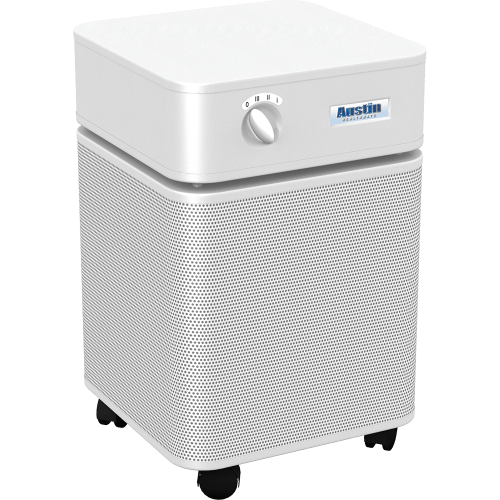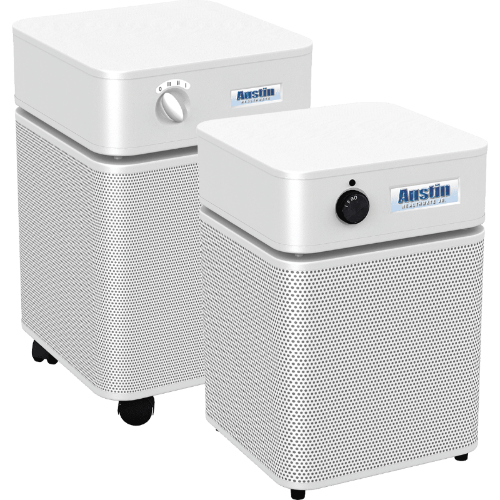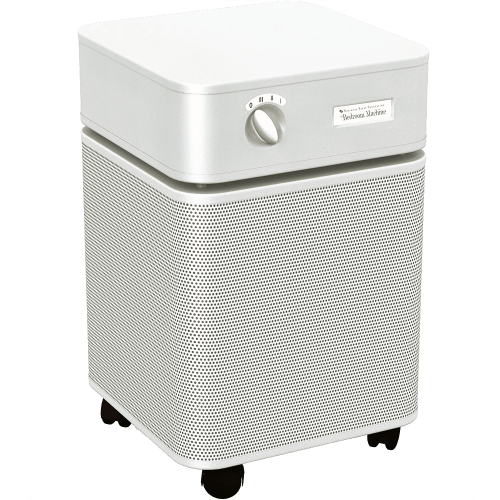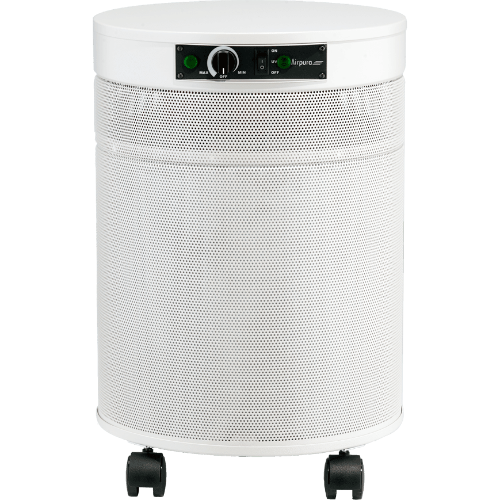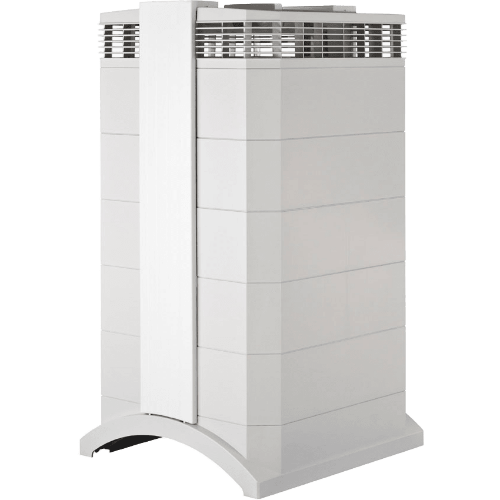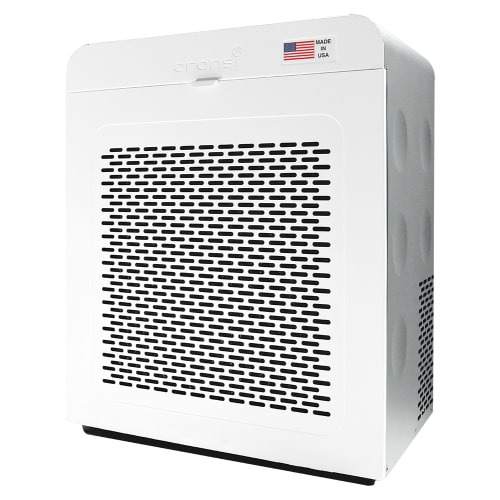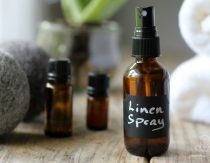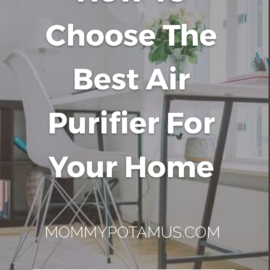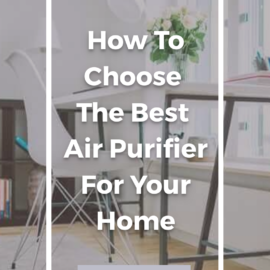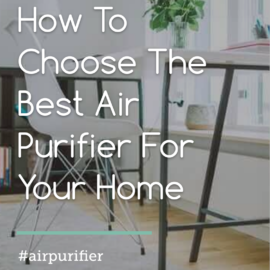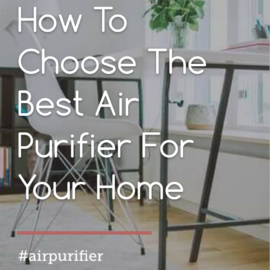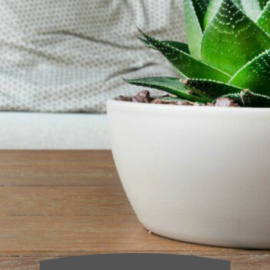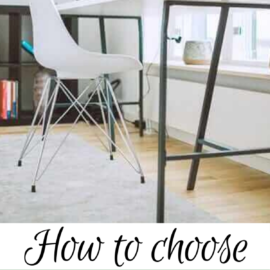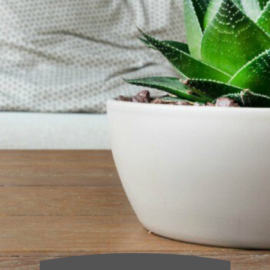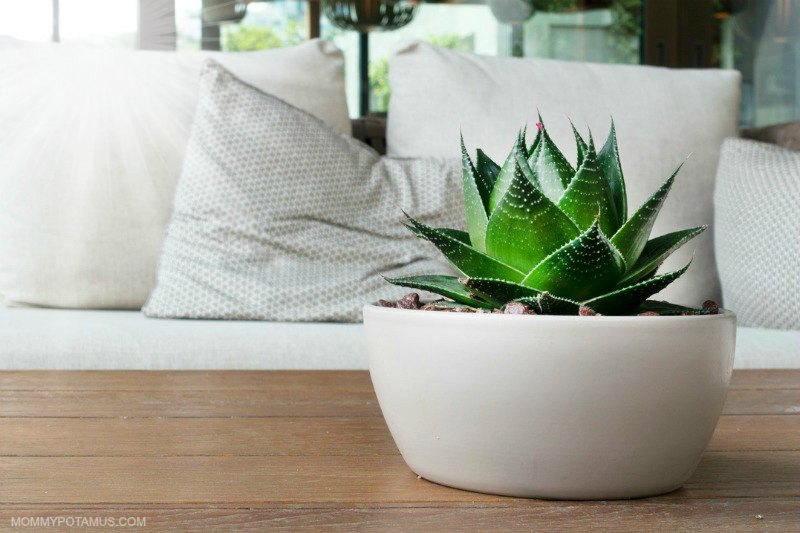
If you could hold a scanner up in your living room and see what’s in the air you’re breathing, what would you see? Oxygen, for sure, and some nitrogen and the carbon dioxide that trees love so much. Unfortunately, if the average indoor environment came with an ingredient label like food does, you’d probably also see:
Flame retardant particles, benzene, formaldehyde from furniture, carpet backing and some fabrics, VOC’s from paint and flooring, pressed wood products, glues and cleaning products, pesticides and more – all of which are linked to short and/or long term health consequences.
Unfortunately, these chemicals are very common in the average home, which is estimated to be 2-5 times (sometimes up to 100 times) more polluted than the air outside. (1) And since many of us spend more than 90% of our lives indoors, that’s a big deal.
When I set out to find the best air purifier for my home, I quickly realized that there’s a lot of hype around some products. So I created spreadsheets, and researched terms like CADR rating, and dove into which types of filters remove which types of toxins. And now I’m putting the results of countless hours of research into this article for you.
We’re going to cover:
- Common pollutants you need to know about
- The difference between activated charcoal filters, HEPA filters, and more
- My top 5 brand recommendations
- Specialized recommendations for unique situations
- So what are these pollutants, and what problems do they cause?
- The 5 Main Types of Air Purifiers
- 1. HEPA Filters
- 2. Activated Carbon
- 3. UV Filters
- 4. Ionic Filters
- 5. Ozone
- Choosing A Model That Meets Your Room Size & Floor Layout Needs
- Best Air Purifier Brands
- Enviroklenz Air System Plus
- Austin Air Healthmate Air Purifiers
- Which Austin Air model is best?
- Airpura UV600 Air Purifier
- IQAir HealthPro Plus
- Oransi EJ120 Hepa Air Purifier
- Frequently Asked Questions

So what are these pollutants, and what problems do they cause? ^
According to the New York Times:
Indoor air pollution has been linked to a wide variety of adverse health effects, including headaches, respiratory problems, frequent colds and sore throats, chronic cough, skin rashes, eye irritation, lethargy, dizziness and memory lapses.
Long-term effects may include an increased risk of cancer. Though children, the elderly and those with chronic ailments like asthma, allergies and heart and lung diseases seem especially vulnerable, symptoms may also occur in otherwise normal, healthy persons.” (2)
People with the MTHFR gene mutation (an estimated 30-50% of the population, including me) might also be considered a vulnerable group due to our reduced ability to detox.
There are thousands of possible pollutants that we could talk about, but here are a few worth worth highlighting:
- Flame retardant particles
- Volatile Organic Compounds (VOC’S)
- Dust, pollen, pet dander
- Mold spores and mildew
- Bacteria and viruses
Let’s take a closer look at how they impact our health:
Flame retardant particles
Some chemical-based flame retardants come from the same family of chemicals as the banned pesticide DDT. They’ve been found in human breast milk, and blood levels of common flame retardants doubled in adults every 2-5 years over a 30 year period. (2) (3)
These chemicals are associated with:
- Lowered IQ
- Developmental problems
- Cancer
- Reproductive problems
- Thyroid dysfunction
Children are especially vulnerable to their effects, yet a huge percentage of products containing fire retardants are made specifically for children.
Unlike VOCs, which dissipate over time, flame retardants tend to accumulate in dust as furniture cushions and other sources go through normal wear and tear. The best strategy for reducing flame retardant particles is to avoid products that contain them (especially furniture and clothing) when possible, but since most of us have some sources in our home manual removal via regular cleaning and air filtration is also important.
Volatile Organic Compounds (VOCs)
Although toxicity varies by the specific compound, VOC’s are associated with cancer, liver and kidney damage, central nervous system damage, eye and respiratory tract irritation, headaches, dizziness, fatigue, loss of coordination, allergic skin reactions, nausea, and memory problems. (4)
They’re found in “household products, including paints and varnishes, cleaning and disinfecting supplies, building materials and furnishings (such as composite wood products), pesticides, craft materials like glues, adhesives, and permanent markers, air fresheners and other synthetic fragrances, dry-cleaned clothing and textiles, carpets, sealing caulks and solvents, vinyl, personal care products and cosmetics.
A few common VOCs are: Acetone, Benzene, Ethylene glycol, Formaldehyde, Methylene chloride, and Perchloroethylene” (5)
Dust, Pollen & Pet Dander
According to the American Lung Association:
“Chronic, ongoing exposure to dust mites at home can dramatically impact the health of people with asthma and those who are allergic or particularly sensitive to mites. These allergens cause an immune system response, known as allergic rhinitis. A dust mite allergy can range from mild to severe.
A mild case may cause an occasional runny nose, watery eyes and sneezing. In severe cases, the condition is ongoing, or chronic, resulting in persistent sneezing, cough, congestion, facial pressure or severe asthma attack. People with asthma who are sensitive to mites face an increased risk of flare-ups or asthma attack.” (5)
Pollen and pet dander can also cause similar reactions for some people.
Mold Spores
Exposure to mold and mildew in the home can have a variety of health effects. Some are allergenic, meaning that they cause irritation for people that are sensitive to them. Others produce compounds that are toxic and can lead to breathing difficulties, fatigue, neurological and other problems.
Bacteria & Viruses
Our home have a microbiome just like our digestive tracts do. In my home, the goal is not to eliminate all microbes, but to discourage the overgrowth of ones that don’t work symbiotically for our benefit.
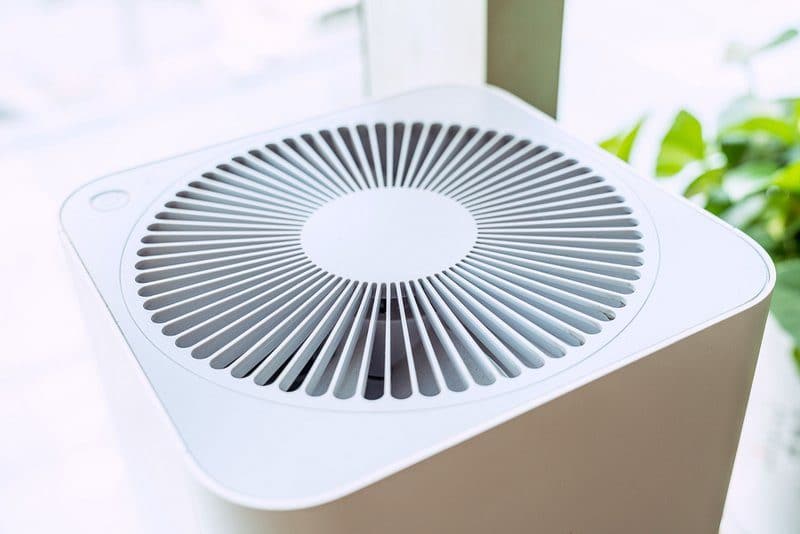
The 5 Main Types of Air Purifiers ^
While there are lots of things you can do to improve indoor air quality, installing a high quality air purifier is by far one of the most impactful.
There are five main types of air purifying technology. None of them address all concerns, which is why they are often combined to make the most effective air purifier possible. Here’s what I learned when I researched the best air purifiers available, plus a review of the one I bought and a few others.
1. HEPA Filters ^
Pros: All High Efficiency Particulate Air (HEPA) filters meet Department of Energy requirements to remove 99.7% of particles that are 0.3 microns or larger from the air. They’re very efficient at removing mold spores, flame retardants, dust, pollen, pet dander and bacteria.
Viruses are typically smaller than bacteria and not necessarily captured well by standard HEPA filters, but some newer HEPA filters trap particles that are 100 times smaller. According to manufacturers, these more powerful HEPA filters are able to capture many viruses. That said, it’s important to remember that both bacteria and viruses will only be captured if they are airborne, so it’s still important to clean surfaces.
According to the Centers for Disease Control, 3% hydrogen peroxide (the kind commonly found on store shelves) “is a stable and effective disinfectant when used on inanimate surfaces.” However, there’s a right way (and a wrong one) to use it.
Cons: HEPA filters are ineffective at trapping gases, fumes, chemicals and odors. They work best when combined with another type of filter that addresses these concerns.
2. Activated Carbon ^
Pros: Activated carbon, also known as activated charcoal, is so good at binding with certain toxins that it’s used in emergency rooms to treat food poisoning.
It can also filter water and whiten teeth naturally, but for our purposes the important thing to know is that it’s very effective at absorbing gases like nitrogen dioxide, fumes, VOC’s like formaldehyde, and other chemicals and odors.
The air filter that’s in my bedroom (a Healthmate Plus, which we’ll discuss below) also incorporates zeolite, which is similar to activated carbon and is very efficient at trapping formaldehyde, ammonia and carbon monoxide.
Cons: Activated carbon doesn’t remove particles like HEPA filters, and also not efficient at removing germs from the air.
3. UV Filters ^
Pros: These filters kill bacteria and viruses using UV lights.
Cons: They don’t filter out large particles like HEPA filters, or gases and chemicals like activated carbon.
4. Ionic Filters ^
Ionic machines emit negative ions that bind to particles, bacteria and viruses, causing them to fall to the floor. Unfortunately, they do nothing to remove them and therefore the toxins are often reintroduced into the air.
Also, ionic filters don’t absorb formaldehyde or other VOC’s, and they emit some ozone which we’ll discuss below. I don’t recommend them.
5. Ozone ^
Although once popular, ozone filters are not very effective at removing indoor pollution, and are considered likely to be harmful to human health by the Environmental Protection Agency. (6) I don’t recommend them.
Choosing A Model That Meets Your Room Size & Floor Layout Needs ^
If you have an open floor plan and/or large rooms, that have good airflow between them, it probably makes sense to invest in just one air filter that covers a significant amount of square feet. Air filters work best in the room they’re placed in, but with sufficient airflow they can eventually filter the air in other rooms, too.
However, if your rooms are divided up with little airflow between them, it might be better to invest in several smaller air filters that can be placed in priority areas like bedrooms and frequently used living areas.
Something else to keep in mind is the difference is that the maximum square feet a purifier can manage is not necessarily the recommended room size. Ideally, the air purifier would clean all the air within a room four times each hour. In each write up below, I’ve included both the maximum amount of square feet recommended by the manufacturer and the recommended room size to achieve for air changes per hour.
Best Air Purifier Brands ^
Based on my research, below are the best “all-around” best air purifiers based on performance, value, and range of contaminants filtered out.
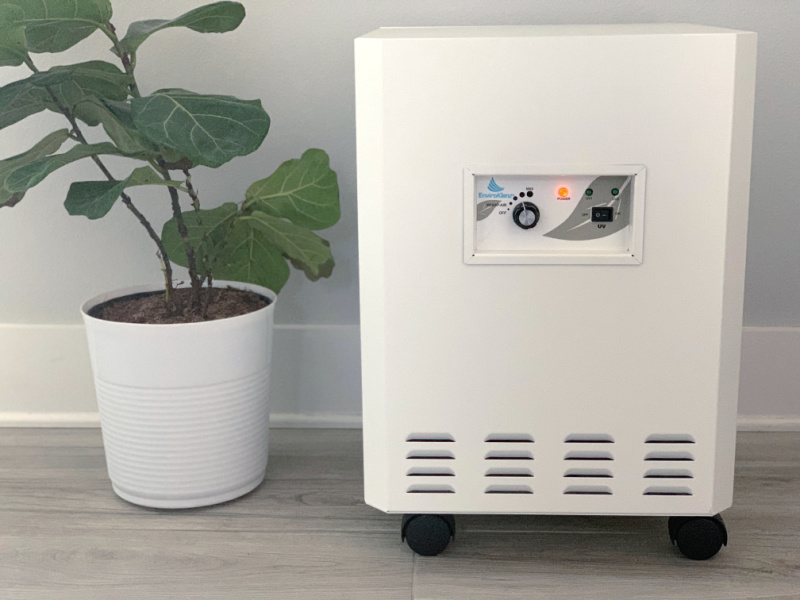
Enviroklenz Air System Plus ^
Developed over two decades by research scientists for the US military, the Enviroklenz is seriously high performance. Its heavy duty filtration is designed to destroy chemical warfare compounds and toxic industrial chemicals.
It uses patented earth mineral technology to capture and destroy airborne toxic and noxious gasses, particulates, allergens, bacteria, viruses, and other allergy triggers.
Last summer, I woke up with water dripping over me and immediately realized that it was coming through our ceiling. My husband and I ran upstairs to find that a water valve had malfunctioned and completely flooded our home.
We immediately called a water remediation company and started drying everything out, but because of my prior experience with mold exposure related illness I went far beyond the usual protocol. In addition to installing dehumidifiers and humidity monitors throughout the house, I gratefully accepted EnviroKlenz’s offer to send me their Air System Plus with UV Filtration.
As you know, I don’t usually accept sample products, because in general I prefer to only recommend products that I would personally purchase with my own money. Given the situation, though, I decided to make an exception because the Air System Plus has something my other systems don’t – a UV system that can effectively filter out mold spores.
Fortunately, multiple air quality tests found that no mold developed in my home because the flood was addressed so quickly and thoroughly, but I love our Enviroklenz and feel it gives me some extra peace of mind as we continue with home repairs.
Price range: $799
Medical grade: Has a hospital-grade HEPA filter. Considered military grade which means it’s designed to remove and destroy toxic and noxious odors, chemicals, and pathogens.
Recommended For: Airborne Toxic and Noxious Gasses, Particulates, Allergens, Bacteria, Viruses, and Other Allergy Triggers.
Types of Filtration Used: EnviroKlenz® Air Cartridge, Hospital grade HEPA filter, UV-C Lamps
Number of Filters To Change: 2 + UV lamps
Filter Indicator: Yes
Independently Tested: Yes
Fan Speeds: 4
Noise Level: 54 – 62 dB
Recommended Room Size: up to 1,000 square feet (based on 3-5 air changes per hour)
Max Square Feet Coverage: 1,000 square feet
Warranty: 5 year mechanical warranty
Pros of the Enviroklenz Air System Plus With UV
- Has been independently tested and proven to remove 99.9% of viruses (tested virus was 0.025 microns) and bacteria (gram-positive and gram-negative)
- Military grade filtration with UV light
- Indicator lights let you know when individual UV-C lamps need to be replaced.
- USA Made
- 5-Year Manufacturer’s Warranty
Cons of the Enviroklenz Air System Plus With UV
- The UV light is visible through the vents on the side of the system at night, but it can be turned off while the rest of the system continues to run. I like to sleep in a very dark room to optimize melatonin levels but I also know that I’ll forget to turn the UV light on in the morning after waking up, so I opted to keep ours in our living room. That way we get the benefit of the UV light without needing to turn it on and off.
- 2 filters to remember to change
Click here to learn more about the Enviroklenz Air System Plus With UV Filtration
Austin Air Healthmate Air Purifiers ^

After a gas leak in Aliso Canyon, California, Austin AIr was the brand trusted to help filter the air in every school classroom within a five mile radius.
By the time the filters were installed air quality tests showed that the leak had already dissipated, which is why no one expected what happened next: test scores went up . . . a lot.
According to this article, this result is “consistent with a growing literature on the cognitive impact of air pollution, which finds that everyone from chess players to baseball umpires to workers in a pear-packing factory suffer deteriorations in performance when the air is more polluted.”
When an airborne-particle physicist and former NOAA scientist used $100,000-plus of equipment to find the best air purifier, he concluded that the Healthmate was the best for individuals who want to remove particulates like mold spores and pollen, plus chemical concerns like formaldehyde and other volatile organic compounds (VOC’s).
In our tests for odor removal, the HealthMate’s 15 lbs. of activated carbon bested all other air purifiers by a wide margin. (For reference, the Coway doesn’t even have a quarter pound of activated carbon.) Its exceptional performance in this area is a big part of why FEMA and the Red Cross chose Austin Air units for deployment at Ground Zero and the surrounding areas in the aftermath of 9/11. (7)
Pros of the Austin Air Healthmate
Trusted Performance
Several clinical trials done with Austin Air purifiers have found positive outcomes. This one conducted by Cincinnati Children’s Hospital found that when a purifier was run in the bedroom at night and in the family room during the day, children with asthma experienced a dramatic reduction in emergency room visits within a twelve month period.
Johns Hopkins University has also conducted clinical trials with Austin Air purifiers. This one found that they decrease nitrogen dioxide and therefore improve indoor air quality, and this one found that it improved air quality in homes where a pregnant woman (and sometimes small children) lived with a smoker.
Low Maintenance Costs Compared To Many Brands
Unlike many units which have three filters which need replacement, Austin Air Healthmate’s only have one . . . and they’re designed to last for five years under normal residential use. (There is a pre-filter that doesn’t need replacing, just periodic cleaning.)
Depending on how many toxins are in the environment is they may need to be replaced before that, though. If you need to replace yours before five years is up, they’ll give you a prorated discount on your new filter.
Cons of the Austin Air Healthmate
No Filter Replacement Indicator
Some models, like the IQAir we’ll discuss below, have an indicator light which shows when the filter needs to be replaced. I set calendar reminders to help me remember to replace mine, or I replace it when it starts to offgas odors. (When the carbon filter that absorbs VOCs is saturated it will do that.)
Not The Quietest Filter
When set to the highest setting they can be twice as loud as two other brands we’ll discuss – Airpura and IQAir. My husband and I moved into a new construction home recently (which was not our Plan A), and the new carpet and paint fumes were overwhelming. We ran two Healthmate purifiers on high in different parts of the house – they’re pretty loud at that setting, but after the initial filtration phase (usually 48 hours to a week) most people set it on maintenance mode (either low or medium).
Because of how strong the VOC’s were in the home we continued to run our air purifiers on high overnight for awhile, but during the day we turn them down to low or medium and I don’t notice them at all. It’s made a huge, noticeable difference in air quality for us.
Which Austin Air model is best? ^
Although they make models that specialize in one particular contaminant or another, I think their models that filter a wide variety of contaminants are the best. Here are the ones worth considering:
Healthmate & Healthmate Jr.
So, the first thing you need to know about these two are that they perform exactly the same. The only difference is that the amount of square feet they can cover.
Price range: $414.99 for the Jr. and $594.99 for the larger one (both are on sale right now here)
Medical grade: Yes
Recommended For: Odors & Chemicals (VOCs), Allergens, Mold Spores, Smoke, Bacteria & Viruses, Multiple Chemical Sensitivity (MCS)
Types of Filtration Used: Pre-filter to capture visible dust and pet dander, medium particle filter for partial removal of mold spores, pollen, dust mites and other allergens, 15 pounds of carbon and natural zeolite to remove odors, chemicals, gases, fumes, and VOCs, then 60 square feet of true medical-grade HEPA (High Efficiency Particulate Air) material to remove bacteria and viruses as well as smaller pollen, mold, pet dander, dust, and ragweed particles.
Number of Filters To Change: 1
Filter Indicator: No
Independently Tested: Yes
Fan Speeds: 3
Noise Level: 50-66 dB for the Healthmate and 49-65 dB for the Healthmate Jr.
Recommended Room Size: 350 square feet for the Healthmate Jr. (based on 4 air changes per hour) and 750 square feet for the Healthmate (based on 4 air changes per hour)
Max Square Feet Coverage: Up to 700 square feet for the Healthmate Jr. and up to 1500 square feet for the Healthmate
Warranty: All Austin Air purifiers are backed by a manufacturer’s 5 year mechanical assembly warranty under normal residential use, as well as a 5 year pro-rated HEPA cartridge warranty. Made in the USA.
Click here to shop for the Healthmate or Healthmate Jr.
Healthmate Plus & Healthmate Plus Jr.
The Healthmate Plus is the same as the basic Healthmate except it incorporates an additional filtration medium (potassium iodide) into the carbon filter for more powerful adsorption of odors, gases, and chemicals. This is the model I have in my bedroom and my kids bedrooms.
Price range: $464.99 for the Jr. and $714.99 for the larger one
Medical grade: Yes
Recommended For: Odors & Chemicals (VOCs), Allergens, Mold Spores, Smoke, Bacteria & Viruses, Multiple Chemical Sensitivity (MCS)
Types of Filtration Used: Pre-filter to capture visible dust and pet dander, medium particle filter for partial removal of mold spores, pollen, dust mites and other allergens, 15 pounds of carbon, natural zeolite, AND potassium iodide to absorb heavy odors, chemicals, gases, fumes, and VOCs, chemicals, gases, fumes, and VOCs, then 60 square feet of true medical-grade HEPA (High Efficiency Particulate Air) material to remove bacteria and viruses as well as smaller pollen, mold, pet dander, dust, and ragweed particles.
Number of Filters To Change: 1
Filter Indicator: No
Independently Tested: Yes
Fan Speeds: 3
Noise Level: 50-66 dB for the Healthmate Plus and 49-65 dB for the Healthmate Plus Jr.
Recommended Room Size: 375 square feet for the Healthmate Plus Jr. (based on 4 air changes per hour) and 750 square feet for the Healthmate Plus (based on 4 air changes per hour)
Max Square Feet Coverage: Up to 700 square feet for the Healthmate Plus Jr. and up to 1500 square feet for the Healthmate Plus
Warranty: All Austin Air purifers are backed by a manufacturer’s 5 year mechanical assembly warranty under normal residential use, as well as a 5 year pro-rated HEPA cartridge warranty. Made in the USA.
Click here to shop for the Healthmate Plus or Plus Jr.
Austin Air Bedroom Machine
The Bedroom Machine is a step up from the Healthmate Plus. It uses a fifth layer of filtration – a HEGA carbon filter made from military-grade activated carbon cloth – which enables it to absorb even more odors, gases, chemicals an VOCs. It’s built to meet the requirements set out by the Johns Hopkins University Medical School and endorsed by the National Sleep Foundation.
Price range: $844.99
Medical grade: Yes
Recommended For: Odors & Chemicals (VOCs), Allergens, Mold Spores, Smoke, Bacteria & Viruses, Multiple Chemical Sensitivity (MCS)
Types of Filtration Used: Pre-filter to capture visible dust and pet dander, medium particle filter for partial removal of mold spores, pollen, dust mites and other allergens, 15 pounds of carbon and natural zeolite to remove odors, chemicals, gases, fumes, and VOCs, then 60 square feet of true medical-grade HEPA (High Efficiency Particulate Air) material to remove bacteria and viruses as well as smaller pollen, mold, pet dander, dust, and ragweed particles, plus a HEGA (High Efficiency Gas Absorption) filter constructed of military-grade activated carbon cloth acts as double protection against odors, gases, chemicals, and VOCs
Number of Filters To Change: 1
Filter Indicator: No
Independently Tested: Yes
Fan Speeds: 3
Noise Level: 50-66 dB for the Healthmate Plus and 49-65 dB for the Healthmate Plus Jr.
Recommended Room Size: 750 square feet (Based on 4 air changes per hour)
Max Square Feet Coverage: Up to 750 square feet
Warranty: All Austin Air purifers are backed by a manufacturer’s 5 year mechanical assembly warranty under normal residential use, as well as a 5 year pro-rated HEPA cartridge warranty. Made in the USA.
Click here to learn more about the Bedroom Machine
Airpura UV600 Air Purifier ^
The “UV” in UV600 stands for UV light, which is what makes the Airpura UV600 unique. In addition to a true HEPA filter and activated carbon filter, it incorporates a 20 watt UV germicidal lamp which kills micro-organisms (viruses, bacteria, and mold spores) that are trapped during the filtration process
The ultraviolet lamp is about twice the size of most lamps used in air filters, making it about twice as powerful. It can be switched on an off.
Price range: $899.98
Medical grade: Yes
Recommended For: Odors & Chemicals (VOCs), Allergens, Mold Spores, Smoke, Bacteria & Viruses, Multiple Chemical Sensitivity (MCS)
Types of Filtration Used: CleanablePre-filter, 18 pounds of activated carbon, 40 sq. ft. of True HEPA filter material, 20-watt germicidal UV lamp
Number of Filters To Change: 3
Filter Indicator: No
Independently Tested: Not this model that I could find, but it is certified by the California Air Resources Board (CARB) and Airpura is considered one of the most reputable companies for residential air purification.
Fan Speeds: 2
Noise Level: 28.1 – 62.3 dB
Recommended Room Size: 1050 square feet (Based on 4 air changes per hour)
Max Square Feet Coverage: 2000 square feet
Warranty: 5 years parts and 10 years labor (excluding replacement filters)
Pros of the Airpura UV600
- UV filter
- Super quiet
Cons of the Airpura UV600
- 3 filters to remember to change instead of just one
Click here to learn more about the Airpura UV600
IQAir HealthPro Plus ^
Like the filters above, the IQAir HealthPro Plus is a hybrid HEPA filter and activated carbon filter. It only contains five pounds of carbon versus 15 pounds of activated carbon/zeolite in the Healthmate Plus and 18 pounds in the Airpura).
However, while some air purifiers only capture particle sizes of 0.3 microns or 0.1, this one captures particles as small as 0.003. Viruses are between 0.0005 and 0.3 microns, so they’re larger than the particle size the IQAir is capable of capturing.
Also, it has a display that shows you how much filter life is left.
Price range: $899
Medical grade: Yes
Recommended For: Odors & Chemicals (VOCs), Allergens, Mold Spores, Smoke, Bacteria & Viruses, Multiple Chemical Sensitivity (MCS)
Types of Filtration Used: Pre-filter, PreMax Pre-filter, 5 poundsgranulated activated carbon and impregnated alumina, HEPA Filter
Number of Filters To Change: 3
Filter Indicator: Yes
Independently Tested: Yes
Fan Speeds: 6
Noise Level: 25 – 69 dB
Recommended Room Size: 563 square feet (based on 4 air changes per hour)
Max Square Feet Coverage: 1125 square feet
Warranty: 10 year limited warranty
Click here to learn more about the IQAir Healthpro Plus
Pros of the IQAir HealthPro Plus
- Filters particles that are up to 100 times smaller than conventional HEPA filters (the other ones on this list are all medical grade and also filter better than basic HEPA filters, but this one filters the smallest particles)
- Programmable timer
Cons of the IQAir HealthPro Plus
- Larger than some models – takes up more visual space in a room
- Only one color option
- 3 filters to remember to change instead of just one
Oransi EJ120 Hepa Air Purifier ^
Rated by CNN as the Best Air Purifier for Large Homes 2019 and used by organizations such as Google, NASA, and the American Red Cross, the Oransi EJ120 is the only Energy Star efficient air purifier that made the list.
Although it’s made in the USA, the company originally discovered the EJ120s German-built motor at the same factory that makes the Tesla engine. Most air purifiers are engineered with alternating current (AC) motors, which are not energy efficient. The Oransi EJ is engineered with a an electrically commutate (EC) motor that delivers on both performance and energy efficiency while operating quietly. Some estimates say an EC motor will save about $168 per year in energy costs.
Aside from energy efficiency, the motor offers strong airflow (which is needed to filter effectively) without a lot of noise. Although this purifier will absorb VOCs and chemicals, I think where it really shines is removing allergens and particulates.
Price range: $999.95 (another store sells it for 899 but they are out of stock right now due to demand)
Medical grade: Yes
Recommended For: Allergens, Mold Spores, Smoke, Bacteria, Odors & Chemicals (VOCs)
Types of Filtration Used: Pre-filter, 1” deep pleated activated carbon filter that uses proprietary carbon technology. Effective for a variety of VOCs, gases (methane gas, sulfur gases, and many others) and smoke. Medical grade true HEPA filter (MERV17) that removes 99.97% of household allergens down to 0.3 microns in size, 98.79% at 0.1 microns and 97.34% at 0.03 microns (30 nanometers).
Number of Filters To Change: 2
Filter Indicator: Yes
Independently Tested: Yes
Fan Speeds: 5
Noise Level: 40 – 59 dB
Recommended Room Size: 720 square feet (Based on 4 air changes per hour)
Max Square Feet Coverage: 1500 square feet
Warranty: 10 years
Pros of the Oransi EJ120
- Filter change indicator
- Energy efficient
Cons of the Oransi EJ120
- Only one color option
Click here to buy the Oransi EJ120
Frequently Asked Questions ^
Why didn’t you mention the Molekule Air?
The airborne-particle physicist and former NOAA scientist I mentioned in the article requested a unit from Molekule to test alongside the others. Molekule wanted their filter to be tested under special testing conditions that the scientist said he “could not agree to,” so it was not evaluated. However he did have this to say:
“Molekule advertises its technology as PECO—photo-electrochemical oxidation. It is a variant of photocatalytic oxidation, or PCO, which came to prominence in the 1990s, as a way of eliminating ethylene—a ripening agent naturally produced by fruit—in cold-storage fruit warehouses. In the early 2010s, a PCO home purifier, the Airocide, was introduced to great fanfare but deeply dubious results. Molekule’s PECO variant is 15 to 100 times faster than what we’ve seen before, but Molekule says (in our lengthy interviews and in its own literature) that the fundamental chemistry is similar if not identical.”
What do you think of BlueAir?
I like that they are quieter than many filters, but they’re not medical grade and they emit Wifi. Personally, I prefer to avoid Wifi enabled products.
Want a FREE ebook of non-toxic cleaning recipes that WORK?
I’ve created a free ebook for you as a gift for signing up for my newsletter. 7 Non-Toxic Cleaning Recipes That Really Work covers seven recipes that you can make in just a few minutes each for squeaky clean windows, sparkling dinnerware, lemon-fresh countertops, and more. Subscribe to my newsletter below and you’ll be redirected to a download page for immediate access to this PDF ebook.
Sources For This Article
1. Environmental Protection Agency: Why Indoor Air Quality is Important to Schools
2. New York Times: Dangers of Indoor Air Pollution
3. Environmental Protection Agency: A Guide To Indoor Air Quality
4. Joshi, Sumedha (2008) The Sick Building Syndrome
5. Environmental Protection Agency: Volatile Organic Compounds’ Impact on Indoor Air Quality
6. Environmental Protection Agency: Ozone Generators that are Sold as Air Cleaners

